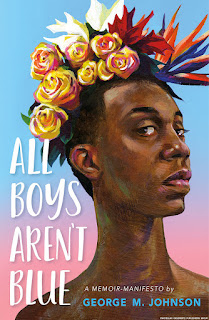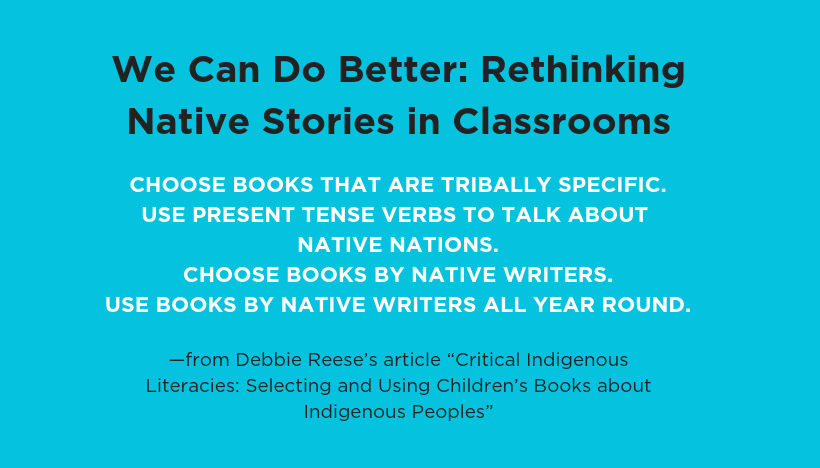(Editor's Note, November 8, 2013: I've been casting about trying to find words to explain what is wrong with the idea that the Pilgrims and Wampanoag's sat down together and had a wonderful meal together. Below, I note that things that happened before that meal are usually missing from the way the event is portrayed in children's books. But I think Jill Lepore's words get at what I find troubling about the "wonderful meal" idea. In the 'After the Mayflower" episode of the PBS documentary "We Shall Remain," Lepore says that everyone there was very nervous. The Pilgrims, the documentary says, were especially wary of close contact with the Wampanoag people. That anxiety, I think, makes the depictions of a meal characterized by warmth and happiness disingenuous.)
Are you looking for children's books about Thanksgiving?!! The exclamation points convey my frustration with the insistence that this holiday be one in which people want Thanksgiving to be about Pilgrims and Indians sitting down to eat a meal together--nevermind what happened to Native people before or after that! Did you know, for instance, that Tisquantum--more commonly known as Squanto--could speak English because he'd been kidnapped by a prior expedition and sold into slavery in Europe? And did you know that before the Mayflower arrived, the Wampanaog people had been devastated by disease from earlier European visitors?
If you've written to me or to other Native critics, educators, or librarians, to ask for children's books about Thanksgiving, it is likely because you want to give the children in your care or in your classroom something better than the standard Pilgrim/Indian story where everyone sits down to a lovely dinner.
Prompted by readers of AICL, I took some time today to head over to the local B&N and see what kind of books about Thanksgiving they might have on display.
Here's the shelf (sorry---photographs in this post are of low quality):
There are four rows of books on the display. Here's some photos and observations of them, starting from top left:
What is Thanksgiving? by Michelle Medlock Adams, illustrated by Amy Wummer. Published in 2009 by Candy Cane Press, here's the synopsis (from Amazon):
Following the success of What Is Christmas? and What Is Easter?, Michelle Adams brings the same humor and warmth to this little Thanksgiving board book. Through the whimsical art and rhyming verse that's fun to read, even the youngest child will come to understand that Thanksgiving is really about showing gratitude for all the blessings in our lives.
Adams and Wummer steer clear of any attempt to show Indians as part of their book. Their collaboration has Pilgrims, but no Indians:
I don't know about that... Doesn't seem right to just omit Native people, but I don't want the stereotypes OR the feel-good story, either. Sometimes I think that Thanksgiving books for young children should just focus on things people are grateful for. What is Thanksgiving? tries to do that, but having Pilgrims (and a turkey) but no Wampanaog people just doesn't seem right.
Five Silly Turkeys does not have Pilgrims or Indians in it.
Happy Thanksgiving Day by Jill Roman Lord is a 'touch and feel' book (for those of you who don't know what they are, touch-and-feel books have textures embedded in each page that young children can touch, thereby having a multi-sensory experience). Published in 2013 by Ideals Pub, this page shows the little boy's artwork taped to his wall. See? Pilgrims, but no Indians (the bear's belly has a swatch of fabric for a child to feel).
Happy Thanksgiving, Curious George by Cynthia Bartynski and Julie M. Young, illustrated by Mary O'Keefe was published in 2010 by Houghton Mifflin Harcourt. It is also a board book. For most of it, George is shown in a Pilgrim hat. No Indians or feathers, anywhere, till one of the last pages:
See the Indian figurines in the left margin? They're also on the table. Those things on the back of everyone's chair are turkey feather decorations that George made.
Pete the Cat: The First Thanksgiving by Kimberly and James Dean was published in 2013 by HarperFestival. Here's the synopsis from Amazon:
Starring in the school Thanksgiving play would make even the coolest cat nervous. But when Pete the Cat gets onstage, he makes learning the story of the first Thanksgiving fun. With thirteen flaps that open to reveal hidden surprises, this book is sure to be a holiday favorite for every Pete the Cat fan.
Though Amazon lists it (today) as their #1 children's book about Thanksgiving, the reader reviews pan it. One person said it is "superficial" but most others don't like it because it is missing the qualities of the other Pete the Cat books. Here's what I find problematic:
That character is supposed to be Squanto. Here's what the text says: "The Pilgrims had heard about the Native Americans, and they worried that they would not be friendly. Pete had never met a cat he didn't like, so he thought they would be kind." Here's another page:
Moving along!
Happy Thanksgiving, Biscuit! by Alyssa Satin Capucilli, illustrated by Pat Schories, came out in 1999. Like Pete the Cat: The First Thanksgiving, it is from HarperFestival. I like the Biscuit books. He is so cute! In this lift-the-flap book, there are no Indians or Wampanoags. There are, however, Pilgrim dolls.
See the man propped up against the bench that has Biscuit's food dish? The woman is face down by Biscuit's hind feet.
The Night Before Thanksgiving is about a family getting ready for Thanksgiving. No pilgrims or Indians, either. Dare I say it? "Thankfully!" Some people really object to my being snarky. Ah well.
One Little, Two Little, Three Little Pilgrims by B. G. Hennessey, illustrated by Lynne Avril Cravath is pretty awful, in my mind. Just the idea of using that song makes me cringe! I did a bit of poking around and found a video of kids singing it, wearing Pilgrim hats and bonnets, and feathered headbands. But instead of saying Wampanoag, they sang "Native Americans." Why, I wonder? In the book, the two groups (Pilgrims/Wampanoags) are shown working (cooking, fishing, etc.) to get ready for their shared meal. Looking at the illustrations, I wonder why the Wampanoag's all have a dash of facepaint on their cheeks? In every illustration? Why? (Update, Nov 8: A reader noted that the Pilgrims also have that same dash of facepaint, suggesting it has something to do with the author's style of illustration. Good point!) Here's the cover:

Next up? Nate the Great Talks Turkey. Written by Marjorie Weinman Sharmat and Mitchelle Sharmat, the illustrations are by Jody Wheeler. Unlike the ones above, this is not a picture book. And, it isn't about Thanksgiving. Published in 2013 by Delacourt Books for Young Readers, it is about a turkey on the loose. There is, however, a gesture to Thanksgiving early on:
I don't know what happens later in the book. Maybe they're going to catch it, but I kind of doubt they'd kill and eat it. The last book on the second shelf is The Pilgrims First Thanksgiving by Ann McGovern. Illustrated by Elroy Freem, it was published in 1993 by Scholastic. Partway through the book, we're introduced to Squanto! On the page just before this one, the text tells us that the Pilgrims made a good friend who helped them, and that his name was Squanto.
I wonder what children today learn about Squanto? Given that November is Native American Month, it is depressing to see how Native peoples are depicted (or not) in these books. I'm going to stop here and leave the last two shelves and another book that was on the backside of the display, for another day... Your comments (and pointers to my typos) are welcome!



























